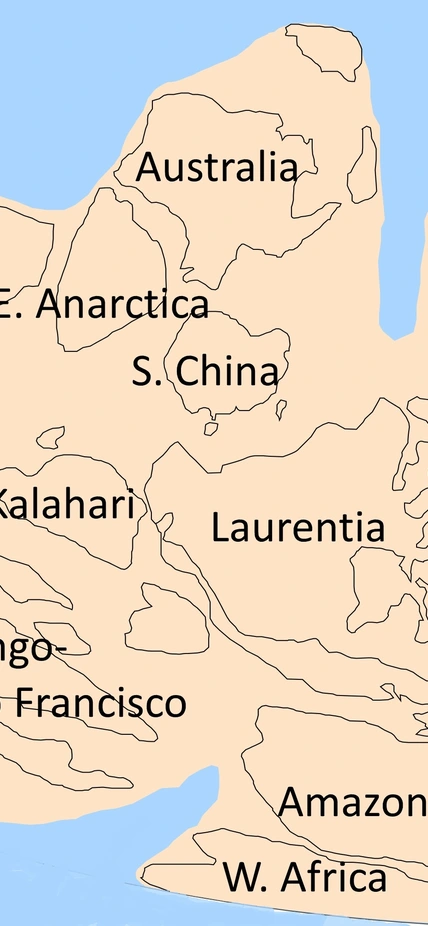Many people have heard of Pangaea, the supercontinent that included all continents on Earth and began to break up about 175 million years ago. But before Pangaea, Earth’s landmasses ripped apart and smashed back together to form supercontinents repeatedly. This cycle has been going on for at least the last 3.0 billion years of Earth’s history, regulating our planet’s geography, climate, and carbon cycles.
Each supercontinent has its quirks, but one, called Rodinia, assembled from 1.3 to 0.9 billion years ago and broken up about 0.75 billion years ago, is particularly odd. A study led by Carnegie's Chao Liu and Robert Hazen (also the Deep Carbon Observatory's executive director), and Harvard University's Andrew Knoll, describes why Rodinia is so unusual in a new paper in Nature Communications.
When looking for evidence of past supercontinents, geologists love grains of zircon, a durable mineral that forms from melted rocks at high temperatures.
“Zircons are so robust that they survive most geologic events,” said Liu. Just like other supercontinents, the number of detrital zircon grains increased during formation and dropped off during breakup of Rodinia. “However, zircon is only one of more than 5,000 different kinds of minerals on Earth,” said Liu. “We thought, maybe we can look at the distribution of other minerals through time to see if they’re different from zircon.”
Liu and his colleagues compiled global records of high-temperature minerals, going back 3 billion years. In addition, they analyzed global data of trace element concentrations in magmatic rocks, which are rocks formed from melted magma, through the last 3 billion years to identify mechanisms controlling how the distribution of minerals changes over time, including zircon. The mineral data revealed patterns that were similar to zircon, with peaks in total mineral records associated with assembly of supercontinents. However, there is one exception. Rodinia had fewer total mineral occurrences compared to other supercontinents.
The researchers noticed that Rodinian minerals bearing niobium and yttrium showed similarly high peaks to zircons. In addition, these peaks nicely couple with higher global concentrations of yttrium, niobium, and zirconium in magmatic rocks of Rodinia, when compared to all other supercontinents.
To explain these findings, the researchers propose that during its formation, Rodinia may have experienced limited arc magmatism. This type of volcanic activity normally prevails during supercontinent assembly, and is associated with subduction, where the edge of one tectonic plate sinks beneath another, and the collisions that create volcanic arcs like the Aleutian Islands, and mountain ranges like the Rocky Mountains and Himalayas. Such tectonic events usually carry robust geochemical signatures of very little zirconium, yttrium, and niobium. Such signatures are relatively limited during Rodinian assembly. Instead, Rodinian geochemistry, mineralogy, and petrology all point to widespread non-arc magmatism.
To explain the general dwarfed mineral records for Rodinia compared to other supercontinents, the researchers speculate that there might have been extensive erosion of the Rodinian volcanic arcs and mountain belts. The enhanced erosion is probably due to the style by which Rodinia was formed, that is, a process called extrovert assembly. After a supercontinent splits apart, the pieces can come together to form a new one through introvert assembly, where the tectonic plates drift back and merge again, or extrovert assembly, where the continents drift further apart and meet up again on the other side of the planet. Plates tend to travel a longer distance during extrovert assembly, which may have led to greater erosion of their margins. The extrovert assembly of Rodinia may also have been accompanied by two-sided subduction, where materials of both colliding plates sink into the mantle, further dooming mineral preservation.
The speculated ‘enhanced erosion’ of Rodinia could significantly impact global carbon cycling, as weathering is a major sink of atmospheric carbon dioxide. For the next step the researchers, together with ore geologist Simone Runyon, a postdoctoral researcher at Carnegie Institution for Science, will examine the ‘enhanced erosion’ speculation carefully. “We’re trying to find out the formation temperature, pressure, and depth of all the Rodinian minerals and compare it with minerals formed during the creation of other supercontinents” said Liu. “I think that’s going to be very interesting.”
Top Image Caption: A proposed reconstruction of the supercontinent Rodinia, about 990 million years ago. Credit: Chao Liu/EarthByte
_____
Courtesy of the Deep Carbon Observatory
